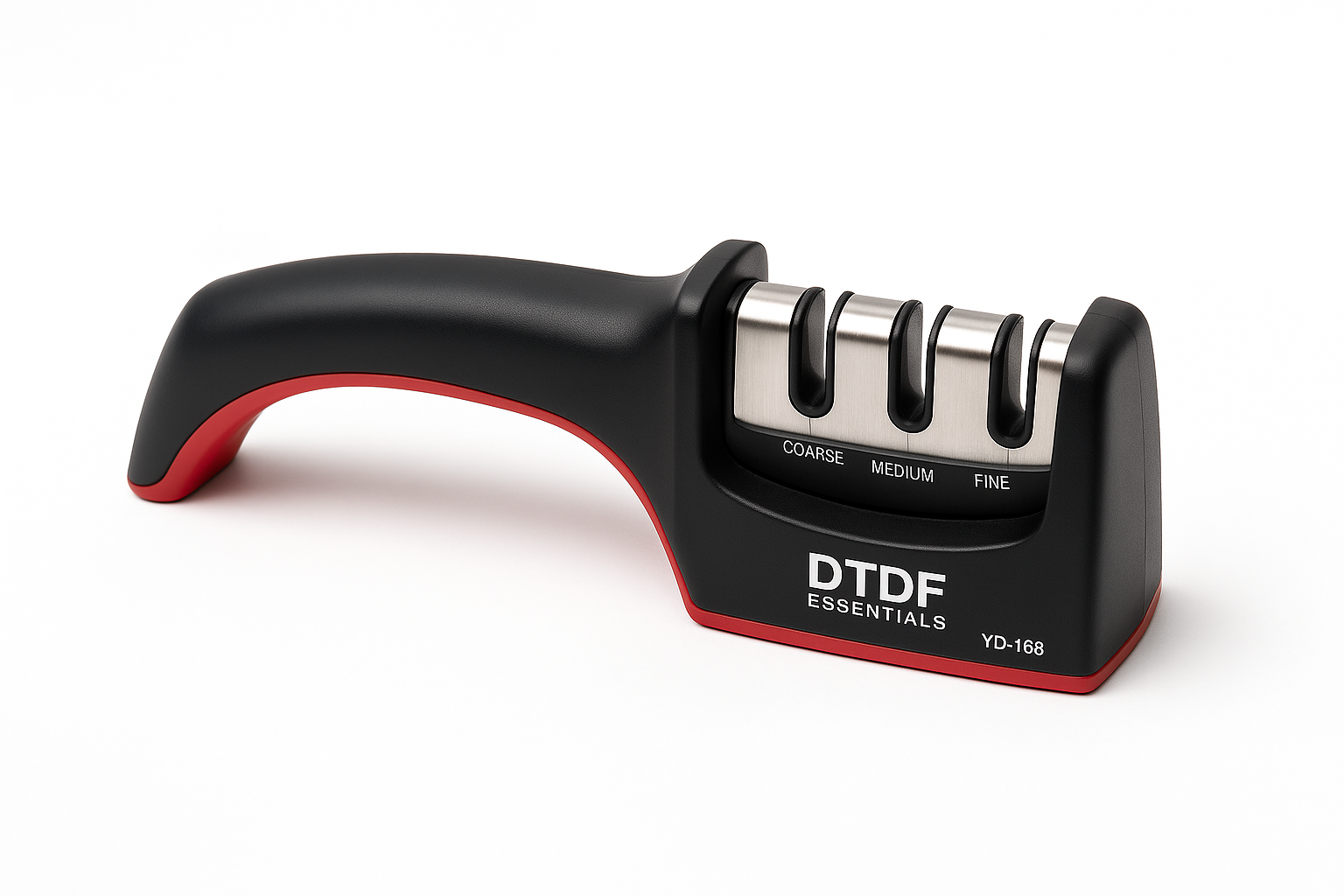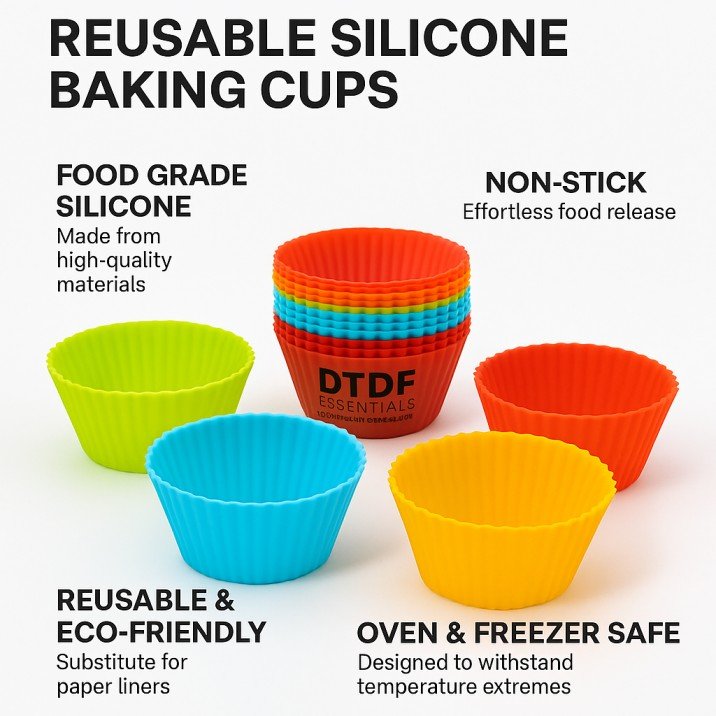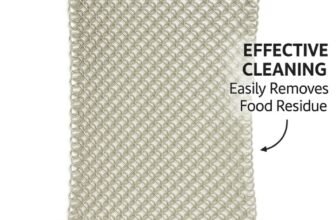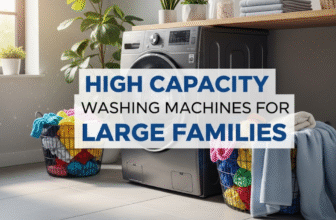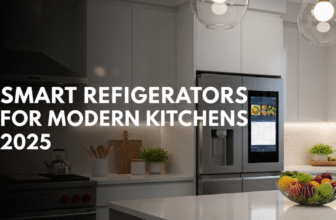Best Knife Sharpener to Keep Your Knives Razor-Sharp
Nothing takes the joy out of cooking quicker than struggling with knives so dulled that they squish tomatoes instead of slicing them cleanly. If you have ever sawed through a chicken breast, or burst into tears while attempting to dice onions, you know the irritation of using blades that have seen better days. A good kitchen knife sharpener can change your life (be it in the kitchen or out of it), while a bad one can put your edge tools (and your mood) on edge.
Buy From AmazonSharp knives aren’t a matter of convenience they’re about safety, ease, and the sheer pleasure of cooking. Your food will turn into delicious dishes easier than ever when your knives slide right through food. And today, we’re going to go over everything you’ll need to know about selecting the right kitchen knife sharpener and the reasons why investing in proper blade maintenance is one of the most intelligent decisions that any home cook can make.
Why Quality Knife Sharpener Is a Must in Every Kitchen
Few home cooks recognize how a sharp knife affects their daily flow in the kitchen. Dull blades require more pressure, which can lead to slipping and cutting yourself. Sharp knives, on the other hand, cut cleanly through with less force, providing more control and leaving your hands less vulnerable.
In addition to safety, sharp knives equal huge time saving in the kitchen. When your chef’s knife moves through vegetables with the smoothness of butter, chopping is quicker and more accurate. And you will see the difference immediately clean cuts without crushing, consistent onion slices, precisely-sized dices whose pieces cook at uniform rates.
The pros know all about that. That’s why they take care of their knives with knife sharpeners with religious fervours: Precise instruments are necessary for precise work. And now with the right sharpening tool, home cooks can achieve similar professional-level of sharpness for their knives without the need for costly knife services.
The 3-Stage Sharpening System Revolution
The truth is that modern knife sharpeners are nothing like the whetstones that were used a long time ago by our grandparents! Today’s top models are so advanced, they’re multi-staged for the complete restoration and maintenance of your blades.
Three part process has become the standard system for maintaining all your fine cutlery. First, the rough sharpening slot is made of tungsten steel and designed for very blunt knives. This first stage will reconstruct the geometry of the blade in preparation of a new edge.
In the intermediate phase, diamond rods are commonly used for exact reshaping. Diamonds are even harder than steel and it is the best material if you want to make the blade angle smoother, sharp and to remove stains during work. This operation turns a working edge into a fine sharp edge.
Finally, the polishing stage takes it to another level with ceramic stones to give you that ultra sharp edge. Ceramic offers the optimal combination of hardness and smoothness, tactility and durability, resulting in an edge that stays sharper longer and is not harder to sharpen. This last step is the defining step between good sharpness and pro level sharpness.
The argument between a manual sharpener and an electric sharpener is an ongoing one amongst cooks. Both methods have their own advantages depending on your requirements and expertise level.
Manual sharpeners offer you control over how much sharpening you want. You control how hard you press, you control the angle, you control how many passes for each blade. This control enables you to have your own preferred honing angle and sharpening for each type of knife and condition. What’s more, manual tools are usually smaller, less noisy, and don’t rely on power.
Electric sharpeners provide a consistency and speed that is hard to match. They hold very consistent angles on their own, and will be able to sharpen even a very dull knife quite quickly. But they take away more metal than you need to lose and can overheat blades if misused.
For the majority of home cooks, the middle-of-the-road manual professional knife sharpeners are the just-right Goldilocks choice. They’re easy enough for beginners but capable enough for professional results. The learning curve is minimal, so after one quick lesson you can perfectly sharpen as many knives as you need quickly and cleanly.
What Makes Sharpening Safe and Easy
Safety should be the first concern while picking a kitchen knife sharpener. Make sure to select models with non-slip bases that don’t fly off your counter as you work through ingredients. A solid sharpener prevents accidents and allows for good blade contact with the sharpening aids.
Ergonomics is the key to avoid Carpal Tunnel Syndrome. Quality handles included in the kit make the difference during long sharpening sessions. The soft-grip material makes it comfortable to hold, so you can enjoy less hand strain and greater ease of use. The design of the grip should be comfortable for those with small hands as well as those with large hands.
Durable construction materials provide lasting performance and function for long term use. The best sharpeners have strong ABS plastic housings that wear well and keep their shape. There should be top quality solid material tungsten steel, a diamond coating, and ceramic stones that work tirelessly like new through hundreds of uses.
Versatility: Beyond Basic Kitchen Knives
The best sharpening tools can tackle more than just a chef’s knife. Accordingly, an all-rounder should be able to work with the full spectrum of kitchen knives – from small paring knives, utility knives, and bread knives to even kitchen shears.
Some sharpeners are unprepared for the demands of serrated blades. In the best systems, there are special slots or procedure options to turn a serrated edge back into a serrated edge without damaging the serrated tooth pattern. With this feature, it prolongs the life of bread knives and other types of knives with serrated edges too often discarded when they go dull.
Kitchen scissors often get omitted from sharpening talks, but these tools are important for food prep and once you find out the difference between cutting with a dull pair versus a maintained one, you’ll see why a little TLC never hurts when it comes to them. A knife sharpener with scissor slot does an amazing job in maintaining your cutting tools in their best form.
Blades of varying thicknesses also need to be accounted for. The best sharpeners are able to accommodate a wide range of blades, from thin paring knives to chunky cleavers, without sacrificing how sharp the blade gets.
Easy to Maintain: Simple Care for Lasting Performance
The finest kitchen knife sharpeners are easy to maintain in their own right. Consider models that have removable parts that can be rinsed off after usage. Sharpening slots also may collect food particles and metal filings, so easy clean out access is essential.
Rust-resistant materials guarantee your sharpener will last with you for a long time. Stainless steel parts and protective coverings stop corrosion from damaging the sharpener and your knives.
Storage considerations matter too. Slim designs that tuck into standard kitchen drawers will increase the odds your sharpener will see regular use. A few models even feature protective covers or storage cases that help keep sharpening surfaces clean and safe when not in operation.
Professional Results Without Professional Costs
Traditional sharpening services can run £3-5 per blade, and often you need to part with your knives for days. For the home cook with many knives, professional sharpening can get pretty pricey, not to mention inconvenient when you need your tools for cooking every day.
A quality sharpener pays for itself every time you use it. More to the point, it’s ready when you are. There is no need to plan ahead or consider service schedules, simply put, sharp knives are always minutes away.
The convenience of having sharp knives available instantly can’t be overstated. When you see a knife grow dull, you just regain the sharp edge in time to make the next cut and avoid ruining the meal or disappointing your family or guests by poor performance.
The Economics of Sharp Knives
Proper knife maintenance means long lasting cutlery. Knives last longer when they are not forced through material. Routine maintenance will stop little problems from escalating to where professional repairs and new knives are needed.
Good kitchen knives are a significant investment. A decent chef’s knife typically costs as much or more than £100 and a full knife set can easily surpass £500. The cost of protecting that investment with regular sharpening makes great financial sense when the alternative is purchasing expensive replacement knives.
The time saved alone is worth the investment. A sharp knife cuts down on prep time, causes fewer tears when chopping onions, and makes food look prettier on the plate. When you count up the number of hours you save over years of cooking (even just from task time, not including cleanup time), the value proposition is even more compelling.
For more kitchen tips and product recommendations, visit Smart Living Dealz for expert advice on home essentials.
Common Sharpening Mistakes to Avoid
Far too many home cooks do irreversible damage to their knives when they sharpen them incorrectly. Exerting too much pressure is probably the most frequent mistake. Good knife sharpeners only need light even pressure – let the surface do the work.
Uneven angles lead to unstable knife edges which break relatively easy. The top manual sharpeners guide your blade into the right position for accurate honing, taking away any guesswork and giving you consistent results every time.
Over-sharpening is another frequent mistake. It’s not necessarily the case that the more passes the better. Do this 3-5 times for each section by pulling the blade through the slot and repeating the process.
Using the wrong stage for your knife’s condition will just waste time and may even harm the blade. Begin with the stage that corresponds to your knife’s level of dullness (it doesn’t have to be the first stage).
When to Sharpen: Reading Your Knives
Recognition for when your blades need TLC is essential to maintain top performance. The paper test is easy and effective — a sharp knife will cut through paper smoothly with no tearing. When the paper rips and the knife fails to slice through it, sharpening is in order.
The tomato test also exposes sharpness issues. A sharp knife can cut through tomato skin without crushing the soft interior. If your knife is mashing instead of slicing tomatoes, it’s most likely time to dust off that kitchen knife sharpener.
Regular routine maintenance works better than waiting for dulling. Regular light sharpening every 2-3 weeks for knives being used every day will allow them to be maintained so that they won’t need harder, more intensive sharpening, which removes more material and shortens the life of the blade.
Storage and Preservation Tips
Good knife storage makes sharpening less frequent. Magnetic strips, traditional knife blocks and blade guards keep knives from grinding against other tools in drawers.
The choice of cutting surface is an important factor that affects edge life considerably. Wood and plastic boards are less harsh on knives compared with glass, stone and ceramic surfaces. You can get twice as much life between sharpening’s if you use the right cutting boards.
Cleaning practices matter too. Hand wash and dry immediately to prevent rust and edge damage from extreme temperatures. Maintaining your knives between sharpening’s maximizes the return on your sharpening tool investment.
Sharpening Comparison: Old and New
Traditional whetstone sharpening has a months-long learning curve, with lots of mistakes to learn from. You need to take considerable time to get that right – traditional stones need skill, time, and knowledge. Though the results can be stellar, the learning curve deters many home cooks. Learning how to manage water, maintain angles and develop good technique requires a lot of practice to develop.
Today’s guided systems such as quality Manual Knife Sharpeners take the guesswork out of professional sharpening results. All the advantages of old school methods with added guides to set the perfect angle and guarantee consistency in your edge from the first use.
Pull-through sharpeners have come a long way since the early models that were hard on knives. The best modern designs employ stepped abrasives and accurate guides that are as effective as traditional methods and available to any skill level.
The Science Behind Sharp Edges
If you know what makes a knife sharp, then you can preserve a blade’s edge longer. The key aspect of knife edges is that two planes meet at a specific angle (usually about 15-20 degrees per side for kitchen knives). The consistency of this angle and the quality of the surfaces are what determine how well the knife slices through materials.
The hardness of the metal is a consideration when it comes to how long an edge holds. Harder steels (higher on the HRC scale) will hold an edge longer but be harder to sharpen. Softer steels are easier to sharpen but need to be sharpened more often. The top professional knife sharpeners easily service hard and soft metals.
Edge geometry varies for every knife and type that the knife might be used for. Slicing knives require narrow, sharp edges, whereas chopping knives require more durable, robust edges. Quality sharpeners accommodate these differences and sharpen appropriately for each use.
Building Your Knife Maintenance Routine
Consistent habit formation makes knife maintenance effortless. Weekly blade inspections let you discover dullness sooner rather than later, when it’s also easier to correct. A quick check as part of normal kitchen clean-up preserves your knives.
Creating your own sharpening station speeds up the process. Keep your kitchen knife sharpener within reach, as well as a towel for clean-up and good lighting to see what you’re doing.
Keeping track of which knives need extra attention ensures that wear is spread evenly across your knife collection. There are knives used frequently that might require more frequent maintenance, and others that only need maintenance every month or season.
Value for the Investment: Cost Per Use Analysis
When comparing knife sharpener choices, look at more than just the initial price – compare the cost per use over the lifetime of the tool. A good sharpener that lasts for years and keeps several dozen knives in peak condition is an excellent deal when you compare it to having it professionally done.
Factor in convenience benefits too. The value of having sharp knives when you need them, every time, contributes significantly to your cooking experience.
The added safety of sharp knives alone makes it worth the price. Sharp knives provide safer cooking with less risk of accidents and the confidence that comes from precise cutting performance.
Conclusion: Transform Your Kitchen Experience Today
A good knife sharpener might be the single most important investment you can make in your kitchen. Sharp knives change everything about cooking, from the actual prep work to the joy of preparing elaborate meals. You’ll be amazed at the safety, ease and the overall satisfaction that comes from cutting through ingredients the way they should be cut.
Advances in sharpening technology have enabled chefs at all levels to attain professional results at home. The systems of today provide the perfect balance between effectiveness and ease, offering exceptional results without the need to spend years in training or investing in costly and complicated devices.
The last thing you need while you’re cooking is a dull tool to slow you down. Whether you’re a weekend meal prepper or a daily cook, the perfect sharpening tool will enhance every meal. Sharp knives are safer, faster to work with and a whole lot more fun to use.
Your knives are eagerly awaiting their transformation. With the right tools and techniques, you can keep your blades razor-sharp and make each cooking session a delight. Get the top-quality knife sharpener today and realize the difference truly sharp knives can make in your cooking! Moreover, do not miss the reduced price for the best professional 3-Stage Kitchen Knife Sharpener with a 33% discount. This sharpener has all the functions that were mentioned in this guide – such as sharpening with tungsten steel and final polishing with ceramics, all gathered in a compact device, easy to use for everyone.
Frequently Asked Questions
1. How often should I sharpen my kitchen knives?
For everyday knives, you should lightly sharpen your knives every 2-3 weeks to maintain peak performance. For seldom-used knives, you will only need to sharpen them every 2-3 months. The blade will remain sharper depending on usage, cutting surfaces, and cutting methods.
2. Can a knife sharpener damage my expensive knives?
A high-quality knife sharpener ensures that the blade remains healthy. This does not mean that you have to apply great pressure or excessive sharpening at any stage. You should always follow the manufacturer’s recommendations and start with less pressure than you think you need.
3. What’s the difference between honing and sharpening?
Whereas sharpening removes metal to create a new blade edge, honing steel realigns the blade’s edge without removing material from it. Kitchen knife sharpeners do the sharpening, while honing steels do the honing.
4. Do you need different methods for different types of knives?
Modern guided systems are constructed in such a way that they can work effectively across all types of knives. Rather than having to worry about the angle, the apparatus maintains the blade angles automatically. However, you may need to perform more passes depending on the current sharpness level.
5. How can I tell if my knife is sharp enough?
The test that works best is the paper test – a sharp knife will slice paper cleanly without dragging or tearing. The tomato test works too; sharp knives can slice through tomato skin without compressing the flesh beneath.
6. How do you sharpen serrated blades with an ordinary sharpener?
Quality professional sharpeners can handle serrated blades as well. Choose models that are especially made for sharpening serrated edges without damaging the tooth pattern.
7. Is it better to sharpen regularly or only when they’ve become very dull?
Light routine maintenance is much better than waiting until blades become very dull. Regular light honing maintains the blade edge, requiring fewer passes, and ensures smooth performance.
Buy From Amazon8. What should I do if my sharpener is not working well?
First, make sure you’ve selected the right stage for your blade’s current condition, and check your pressure. Clean the sharpening surfaces and inspect for wear. Occasionally even very dull, damaged knives must be taken to a professional before returning to normal home maintenance.

